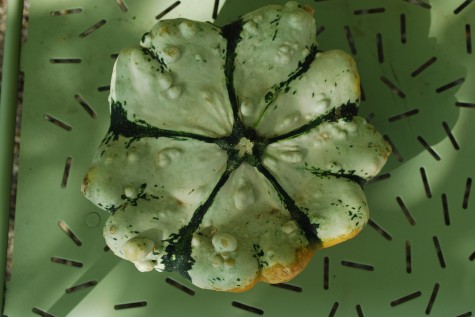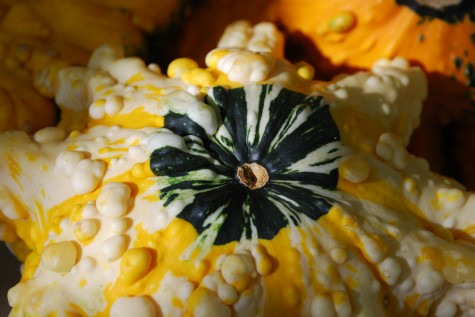 Whether I am drawing a plan, arranging some flowers, building a topiary sculpture, or staging a display, my first move is to determine the order of events. The big gesture comes first. In a landscape plan, I determine the center of interest, or organizing element, and place it. If it is a pool, that pool is assigned a size and a location; any other design is keyed to and in support of that initial decision. If the pool is centered in a space, I work from the middle to the edges of my paper. If that pool is located on a wall at the far end of my space, I would work from back to front, in tandem with establishing the views. As the topiaries that had spent the summer in these pots needed the shelter of a greenhouse, I had four empty pots in search of a reason to be. The idea of these pots overflowing with pumpkins squashes and gourds in some sculptural way had appeal. As these pots are large, a center of interest at a height pleasingly proportional to their width needed to be set first. I used a trio of medium sized pumpkins to get my big pumpkin with its giant stem at the right finished height.
Whether I am drawing a plan, arranging some flowers, building a topiary sculpture, or staging a display, my first move is to determine the order of events. The big gesture comes first. In a landscape plan, I determine the center of interest, or organizing element, and place it. If it is a pool, that pool is assigned a size and a location; any other design is keyed to and in support of that initial decision. If the pool is centered in a space, I work from the middle to the edges of my paper. If that pool is located on a wall at the far end of my space, I would work from back to front, in tandem with establishing the views. As the topiaries that had spent the summer in these pots needed the shelter of a greenhouse, I had four empty pots in search of a reason to be. The idea of these pots overflowing with pumpkins squashes and gourds in some sculptural way had appeal. As these pots are large, a center of interest at a height pleasingly proportional to their width needed to be set first. I used a trio of medium sized pumpkins to get my big pumpkin with its giant stem at the right finished height.
 When working with rounded forms, it rarely works to use a filler material for height. Someplace your filler will show, and give the impression your slip is showing. Trying to cover up a not for viewing interior structure invariably looks like a cover up. Whatever portion of these support pumpkins might show in the finished piece, that portion will look like part of the arrangement. I would not have the faintest idea about how to turn pie pumpkins into pie, but I do know how to use them to provide crooks and crannies to set my prized specimen gourds. I set these beginning pumpkins at an angle which makes their swooping stems part of the action of the sculpture. This helps to make the sculpture look graceful. Every stem set straight up risks that soldierly, grocery store display look.
When working with rounded forms, it rarely works to use a filler material for height. Someplace your filler will show, and give the impression your slip is showing. Trying to cover up a not for viewing interior structure invariably looks like a cover up. Whatever portion of these support pumpkins might show in the finished piece, that portion will look like part of the arrangement. I would not have the faintest idea about how to turn pie pumpkins into pie, but I do know how to use them to provide crooks and crannies to set my prized specimen gourds. I set these beginning pumpkins at an angle which makes their swooping stems part of the action of the sculpture. This helps to make the sculpture look graceful. Every stem set straight up risks that soldierly, grocery store display look.
 As I am interested in placing the largest gourds next, and then, arranging with color in mind, I need to look at averything I have available all at once. This can be quite a nuisance when building a stone wall, but I would not know how to construct it otherwise. In designing a landscape, a lot of shapes, textures and volumes need to be available to your mind’s eye, all at once. I am only good for a random thought that might be pertinent when I am tired; it takes energy to concentrate enough to turn off the daily noise and design. This is easy-get the gourds out, and spread them around.
As I am interested in placing the largest gourds next, and then, arranging with color in mind, I need to look at averything I have available all at once. This can be quite a nuisance when building a stone wall, but I would not know how to construct it otherwise. In designing a landscape, a lot of shapes, textures and volumes need to be available to your mind’s eye, all at once. I am only good for a random thought that might be pertinent when I am tired; it takes energy to concentrate enough to turn off the daily noise and design. This is easy-get the gourds out, and spread them around.
 My big beautiful squashes get placed next. When I look at the four pots from the drive, I see that the pots furthest from my eye will need more emphasis than the pots close to my eye; bigger material is a good way to get what is far away to read better. A small pie pumpkin enables me to tilt the squash out over the edge of the pot, and feature the stem.
My big beautiful squashes get placed next. When I look at the four pots from the drive, I see that the pots furthest from my eye will need more emphasis than the pots close to my eye; bigger material is a good way to get what is far away to read better. A small pie pumpkin enables me to tilt the squash out over the edge of the pot, and feature the stem.
 I finish placing all the large gourds, and stand back for a look. Though not so readily apparent in this picture, I have placed more of the pale or light colored gourds in the rear pots, and the darker colored gourds in the front pots. Dark colors do not read well at a distance, so placing them up front makes the detail of their shape and color read better. Pale colors read fine at a distance, and highlight dark colors placed in front of them. The pots are ready for the little bits-the smallest gourds finish and refine the shape of the overall arrangement. In a landscape, I might be planting roses at this stage, or groundcover as part of the finishing touches.
I finish placing all the large gourds, and stand back for a look. Though not so readily apparent in this picture, I have placed more of the pale or light colored gourds in the rear pots, and the darker colored gourds in the front pots. Dark colors do not read well at a distance, so placing them up front makes the detail of their shape and color read better. Pale colors read fine at a distance, and highlight dark colors placed in front of them. The pots are ready for the little bits-the smallest gourds finish and refine the shape of the overall arrangement. In a landscape, I might be planting roses at this stage, or groundcover as part of the finishing touches.
 The idea is suggest a casual and not too fussy an arrangement. In fact, ordering the placement of sizes permits an arrangement where all the pieces are built sensibly from a large base supporting the fine detail-both visually, and physically. In a large flower arrangement, the interlocking big stems under water provide a framework that will hold the smaller stems where you want them. In a landscape, a long walk indicates how a garden is meant to be experienced-but it also provides weight and organization to the smaller elements you otherwise might not notice. All the elements of any composition need to interlock for a strong presentation of the whole. This front pot features dark and intense colors, with dashes of pale colors here and there.
The idea is suggest a casual and not too fussy an arrangement. In fact, ordering the placement of sizes permits an arrangement where all the pieces are built sensibly from a large base supporting the fine detail-both visually, and physically. In a large flower arrangement, the interlocking big stems under water provide a framework that will hold the smaller stems where you want them. In a landscape, a long walk indicates how a garden is meant to be experienced-but it also provides weight and organization to the smaller elements you otherwise might not notice. All the elements of any composition need to interlock for a strong presentation of the whole. This front pot features dark and intense colors, with dashes of pale colors here and there.
 This rear pot set in a much darker environment relies on the interaction of pale colored shapes for good visibility. The varying shapes and colors of all the little noisy gourds emphasize the mass and grace of the shape of my starring pumpkin.
This rear pot set in a much darker environment relies on the interaction of pale colored shapes for good visibility. The varying shapes and colors of all the little noisy gourds emphasize the mass and grace of the shape of my starring pumpkin.

Pots without much in the way of plants is a welcome change from the summer season. There is a celebration of permutations which have occurred as a result of cross-pollination going on here. The visual explanation – a little feast for the eye.









